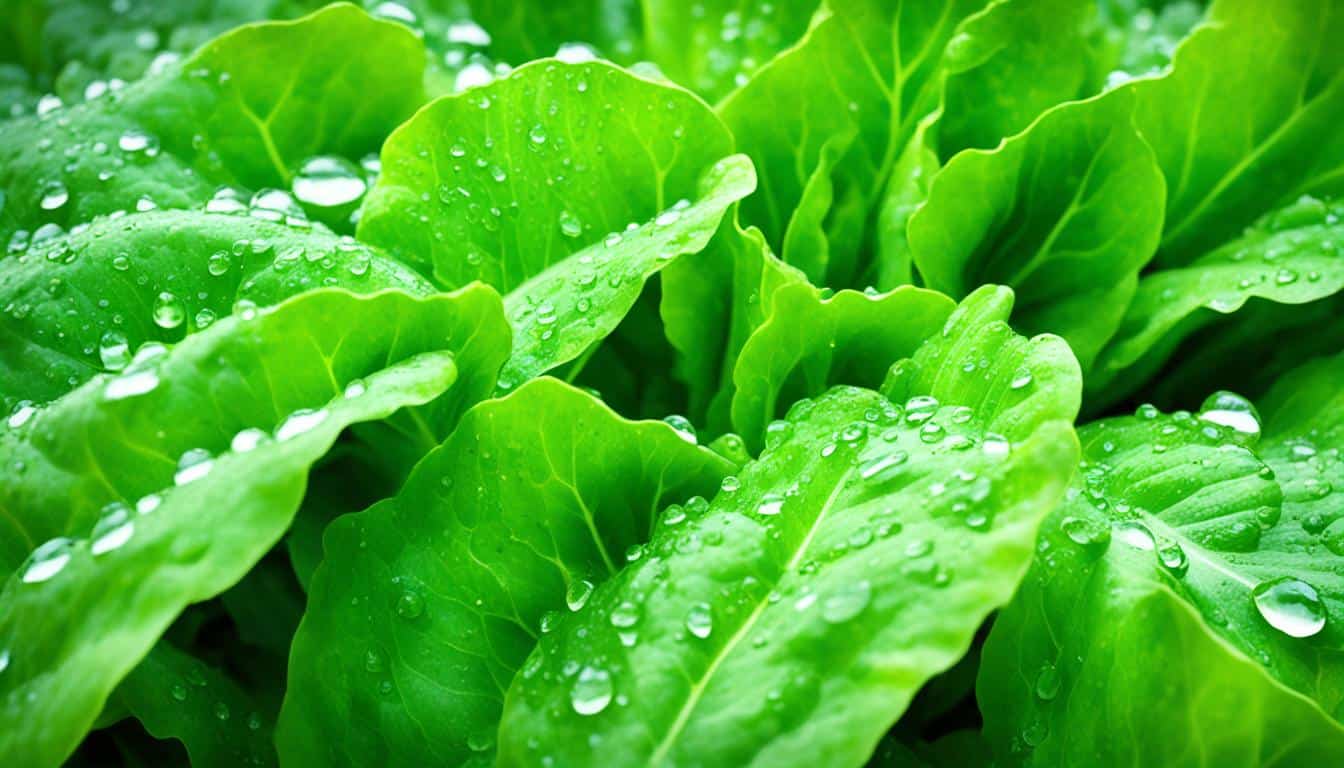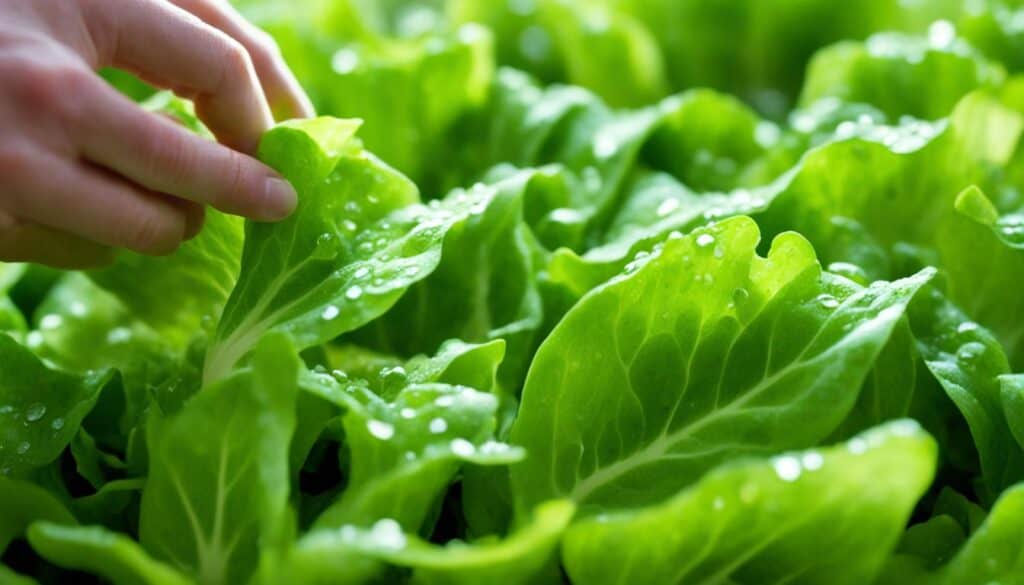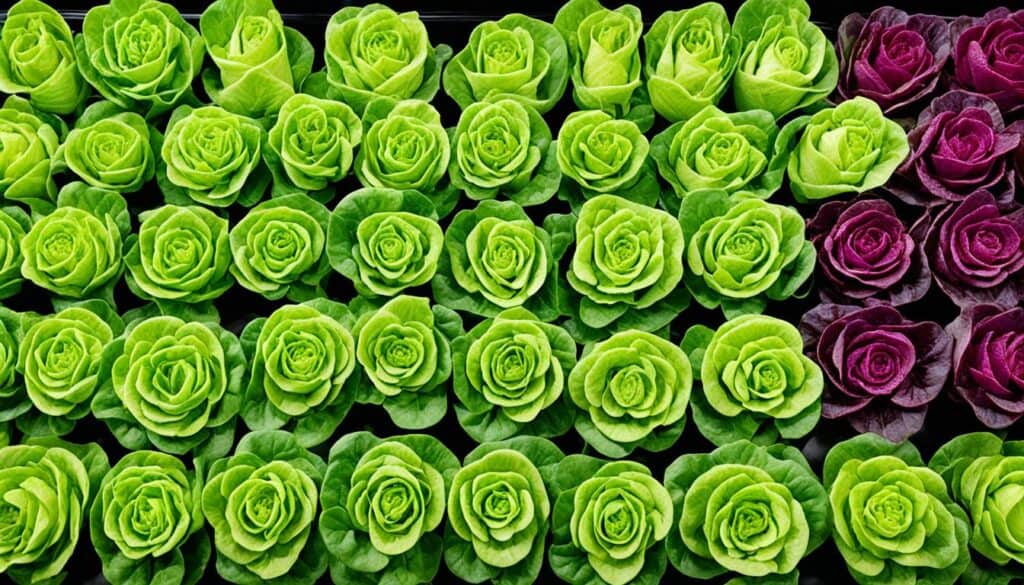Did you know that bibb lettuce, also known as butterhead lettuce, is a cultivar created by horticulturist John M. Bibb in the 1860s? Named after him, bibb lettuce has gained popularity among gourmet chefs and food enthusiasts for its mild, sweet flavor and tender, buttery texture.
Bibb lettuce is not only delicious but also incredibly healthy. It is low in calories and fat, high in water and fiber, and packed with vitamins, minerals, and antioxidants. With its numerous health benefits, bibb lettuce is a fantastic choice for salads, sandwiches, wraps, and more.
To help you make the most of this versatile ingredient, I will provide you with some fresh bibb lettuce recipes and valuable care tips. Get ready to discover new ways to enjoy this leafy green and elevate your culinary creations!
Key Takeaways:
- Bibb lettuce is a cultivar of butterhead lettuce, created by horticulturist John M. Bibb in the 1860s.
- It is known for its mild, sweet flavor and tender, buttery texture.
- Bibb lettuce is low in calories and fat but high in water, fiber, vitamins, minerals, and antioxidants.
- It is a healthy choice for salads, sandwiches, wraps, and more.
- Proper storage, washing, and preparation are essential to maintain the freshness and quality of bibb lettuce.
What is Bibb Lettuce, and Where Does it Come From?
Bibb lettuce is a type of lettuce that belongs to the butterhead variety, one of the four main types of lettuce along with iceberg, romaine, and leaf lettuce. It is also known as butterhead, Boston bibb, or limestone lettuce. It has loose, round heads of soft, delicate leaves that have a smooth, buttery texture and a mild, sweet flavor.
Bibb lettuce was created by horticulturist John M. Bibb in the 1860s by crossbreeding different varieties of butterhead lettuce. It was named after him and became popular in the US and Europe, particularly among gourmet chefs and food enthusiasts.
Bibb lettuce is sometimes called Boston lettuce because it was widely grown and sold in Boston, Massachusetts, in the early 20th century. Another name for bibb lettuce is limestone lettuce, which refers to its cultivation in the limestone-rich soil of Kentucky.
| Type of Lettuce | Description |
|---|---|
| Bibb Lettuce | Loose, round heads of soft, delicate leaves with a smooth, buttery texture and a mild, sweet flavor. |
| Iceberg Lettuce | Tight, compact heads of crisp, watery leaves with a neutral taste. |
| Romaine Lettuce | Tall, elongated heads of crisp, sturdy leaves with a slightly bitter and robust flavor. |
| Leaf Lettuce | Loose, frilly leaves without a defined head, available in various colors and with a mild to slightly bitter taste. |
Farmers usually harvest bibb lettuce when it is young and small, about 4 to 6 inches in diameter, and it has light green leaves that are slightly curly at the edges and a pale yellow or white core. It is typically sold as a whole head or as individual leaves.
What are the Health Benefits of Boston or Bibb Lettuce?
Bibb lettuce, also known as Boston bibb or butterhead lettuce, not only tantalizes your taste buds but also provides numerous health benefits. This delicate and flavorful leafy green is a nutritional powerhouse that is low in calories and fat, making it an excellent choice for maintaining a healthy diet.
One of the standout features of bibb lettuce is its high water and fiber content. This combination promotes hydration and aids in digestion, helping you feel fuller for longer. Additionally, bibb lettuce is packed with essential vitamins and minerals that support overall health.
Vitamin A, found abundantly in bibb lettuce, is crucial for maintaining healthy vision, promoting immune function, and supporting cell growth and development in the body. The vitamin C present in bibb lettuce acts as an antioxidant, protecting against harmful free radicals and boosting the immune system. It also plays a vital role in collagen production, leading to healthier skin.
Another key nutrient found in bibb lettuce is vitamin K, which is essential for blood clotting and bone health. Combined with calcium, bibb lettuce contributes to strong and healthy bones, reducing the risk of osteoporosis.
The folate in bibb lettuce plays a crucial role in DNA synthesis and cell division. It is particularly important for pregnant women, as it helps prevent certain birth defects in developing babies.
Bibb lettuce is also a good source of iron, which is vital for carrying oxygen throughout the body and preventing anemia. Additionally, the potassium in bibb lettuce helps maintain proper fluid balance, supports proper muscle and nerve function, and aids in controlling blood pressure.
One of the most significant advantages of bibb lettuce is its high antioxidant content. Antioxidants protect the body’s cells from damage caused by harmful molecules called free radicals, reducing the risk of chronic diseases like cancer, diabetes, and heart disease.
Moreover, bibb lettuce has a low glycemic index, meaning it does not cause a rapid spike in blood sugar levels. This makes it an excellent choice for individuals with diabetes or prediabetes.
To maximize the health benefits, it is recommended to consume bibb lettuce raw or lightly cooked, as excessive heat can potentially degrade its valuable nutrients and enzymes. It is essential to wash bibb lettuce thoroughly before consumption to remove any dirt, pesticides, or bacteria that may be present on the leaves. Bibb lettuce can be stored in the refrigerator for up to a week, but it is best to consume it promptly to enjoy its freshness and optimal quality.
Incorporating nutrient-rich bibb lettuce into your diet not only adds a delightful crunch and subtle sweetness to your meals but also provides a wide array of health-boosting advantages.
How Do You Choose, Store, and Prepare Bibb Lettuce?
Properly selecting, storing, and preparing bibb lettuce is essential to ensure its freshness and quality. Follow these tips to make the most of your bibb lettuce:
Choosing Bibb Lettuce
When choosing bibb lettuce, look for heads that are:
- Firm, compact, and fresh
- Crisp and tender with a light green color
- Mild and sweet-smelling
Avoid heads that are too large, as they may be overgrown and bitter. Check the label for the harvest date to choose the freshest ones possible.
Storing Bibb Lettuce
To store bibb lettuce:
- Wrap the whole head or individual leaves in a damp paper towel
- Place it in a plastic bag or container
- Store it in the refrigerator’s crisper drawer
Keep bibb lettuce away from ethylene-producing fruits like apples, bananas, and tomatoes, as these fruits can speed up ripening and spoilage.
Preparing Bibb Lettuce
To prepare bibb lettuce:
- Remove the outer leaves and discard any damaged or wilted ones
- Cut off the stem end and separate the leaves
- Rinse the leaves under cold running water
- Pat them dry with a clean cloth or paper towel
Bibb lettuce leaves are delicate, so you do not need to chop or tear them. Depending on your recipe, you can use them whole or halve them.
How Do You Grow Bibb Lettuce at Home?
Growing bibb lettuce at home is a rewarding and sustainable way to enjoy fresh, pesticide-free leaves right from your garden. With minimal effort and the right conditions, you can cultivate this delicious variety of lettuce and add a touch of green to your meals. Let me guide you through the process of growing bibb lettuce at home.
1. Choose the Right Location
Bibb lettuce is a cool-season crop and thrives in temperatures between 45°F and 65°F. Find a spot in your garden that receives at least 6 hours of sunlight daily. If you live in a hot climate, consider providing some shade to protect the lettuce from scorching heat.
2. Prepare the Soil
Ensure that the soil has good drainage and is slightly acidic with a pH level of around 6.0 to 6.5. If your soil is heavy or clay-like, improve its texture by adding organic matter such as compost or well-rotted manure. This will enhance moisture retention and nutrient availability for the lettuce.
3. Planting
Sow bibb lettuce seeds directly into the ground or in pots filled with potting mix. Plant the seeds about 1/4 inch deep and 6-8 inches apart. If sowing in rows, space the rows around 12 inches apart to allow the lettuce heads to develop fully. Water the soil gently after planting to ensure good seed-to-soil contact.
4. Watering and Fertilizing
Keep the soil consistently moist by watering the lettuce regularly. Avoid overwatering, which can lead to root rot or fungal diseases. Mulching around the plants can help retain moisture and suppress weed growth. Fertilize the bibb lettuce every 3-4 weeks with a balanced fertilizer or use organic alternatives such as compost or fish emulsion.
5. Care and Maintenance
Monitor the lettuce plants for any signs of pests or diseases. Remove any weeds that compete for nutrients and water. Protect the lettuce from pests like aphids or slugs by using organic pest control methods. Regularly check and remove any damaged or yellowing leaves to ensure the plants stay healthy.
6. Harvesting
Bibb lettuce is typically ready for harvest around 60-70 days after planting. You can either cut the whole head of lettuce at ground level or selectively pick the outer leaves as needed. Harvesting early in the morning when the leaves are crisp and cool will ensure the best quality and flavor.
By following these simple steps, you can grow your own bibb lettuce at home and enjoy the satisfaction of picking fresh, flavorful leaves right from your garden. Not only does growing bibb lettuce save you money, but it also reduces the carbon footprint associated with transporting store-bought lettuce. Give it a try and experience the joy of cultivating your own nutritious and delicious bibb lettuce!
| Benefits of Growing Bibb Lettuce at Home | Steps to Grow Bibb Lettuce |
|---|---|
|
|
How to Use Bibb Lettuce in Your Cooking?
Bibb lettuce is a versatile ingredient that can be used in various dishes. Its crisp and refreshing texture, along with its mild and sweet flavor, make it the perfect base for salads. Dress your bibb lettuce salad with your favorite vinaigrette, such as balsamic, ranch, or Caesar, and add a variety of ingredients like tomatoes, cucumbers, carrots, cheese, nuts, seeds, fruits, or meats.
Not only is bibb lettuce great for salads, but it can also elevate your sandwiches. Add a layer of moist and crunchy bibb lettuce to your favorite bread and combine it with ingredients like cheese, ham, turkey, bacon, avocado, or hummus. The subtle and pleasant taste of bibb lettuce enhances the overall flavor of your sandwich.
When you’re looking for a low-carb and high-fiber option, wraps are an excellent choice. Use bibb lettuce leaves as wrappers and fill them with rice, beans, cheese, chicken, beef, tofu, or vegetables. The delicate leaves of bibb lettuce provide a light and refreshing wrap that complements a variety of fillings.
Bibb lettuce can also be used in soups to add a smooth and creamy texture with a delicate and mild flavor. Puree bibb lettuce with other vegetables like potatoes, leeks, peas, broth, cream, or milk to create a velvety soup. Alternatively, you can chop bibb lettuce and add it to broth-based soups for an extra layer of freshness.
With bibb lettuce, the possibilities are endless. You can experiment with different combinations and flavors to create your own delicious dishes. Its versatility makes it a valuable ingredient in any kitchen.
Comparing Bibb Lettuce to Other Lettuce Varieties
When it comes to lettuce varieties, Bibb lettuce stands out with its unique characteristics. Let’s compare it to other popular lettuce options to understand what sets it apart.
Bibb Lettuce vs. Iceberg Lettuce
While Bibb lettuce boasts a tender texture and a mild flavor, iceberg lettuce offers a crisp and crunchy texture. If you prefer a softer bite, Bibb lettuce is the way to go.
Bibb Lettuce vs. Romaine Lettuce
Romaine lettuce, known for its firm texture and slightly robust flavor, differs from Bibb lettuce’s delicate and mild taste. If you’re looking for a more substantial lettuce option, Romaine lettuce is a good choice.
Bibb Lettuce vs. Leaf Lettuce
If you favor frilly and vibrant leaves with a slightly crisp texture, leaf lettuce is the lettuce variety for you. Bibb lettuce, on the other hand, stands out with its tender leaves, velvety texture, and mild flavor.
Bibb Lettuce vs. Arugula
Arugula offers a peppery kick and a different flavor profile compared to Bibb lettuce. It lacks the softness and delicate flavor that Bibb lettuce brings to dishes.
In summary, Bibb lettuce’s tender leaves, velvety texture, and mild flavor make it a versatile option for various dishes. Its unique characteristics set it apart from other lettuce varieties, providing a delightful culinary experience.
Selecting and Buying Bibb Lettuce
When it comes to selecting and buying bibb lettuce, there are a few key factors to consider to ensure you bring home the best quality heads. Follow these tips to choose fresh, vibrant bibb lettuce that will elevate your dishes:
- Color and Appearance: Look for leaves that have a vibrant shade of green, indicating freshness. Avoid bibb lettuce with any signs of wilting, browning, or discoloration, as these are indications of decay. The leaves should be tender and have a slight sheen to them, showcasing their quality.
- Texture and Firmness: Give the bibb lettuce a gentle squeeze to check its firmness. High-quality lettuce should feel firm and spring back when lightly pressed. Limp or squishy lettuce is past its prime and won’t deliver the desired crispness in your dishes.
- Aroma: Fresh bibb lettuce should have a clean, slightly sweet aroma. Take a moment to sniff the lettuce before making your purchase to ensure it meets your expectations.
- Seasonality: While bibb lettuce is available year-round, its peak seasons are in the spring and early summer. During these months, you can expect the best flavor and texture from this versatile lettuce variety.
You can find bibb lettuce at various locations, including local farmers’ markets, grocery stores, and specialty food stores. When shopping, it’s important to choose reliable sources that prioritize freshness and quality. Be sure to check the lettuce section regularly to discover the freshest batch available.
Comparing Bibb Lettuce to Other Lettuce Varieties
When comparing bibb lettuce to other popular lettuce varieties, each offers its unique characteristics. Here’s how bibb lettuce stacks up against some other common lettuce types:
| Lettuce Variety | Texture | Flavor |
|---|---|---|
| Bibb Lettuce | Tender | Mild, Sweet |
| Iceberg Lettuce | Crisp, Crunchy | Mild |
| Romaine Lettuce | Firm | Slightly Robust |
| Leaf Lettuce | Slightly Crisp | Pronounced Taste |
| Arugula | Tender, Peppery | Distinctive |
Bibb lettuce stands out with its velvety texture, tender leaves, and mild flavor, making it an excellent choice for various dishes.
Properly Cleaning and Preparing Bibb Lettuce
When it comes to enjoying the freshness of bibb lettuce, proper cleaning and preparation are essential. Follow these steps to ensure that your lettuce is clean, crisp, and ready to use:
- Gently separate the leaves of the bibb lettuce and place them in a large bowl filled with cold water.
- Swish the leaves around in the water to loosen any dirt or debris that may be clinging to them.
- Transfer the leaves to a colander and rinse them under running water. Gently rub each leaf to remove any remaining dirt.
- If there is stubborn dirt or sand, give the leaves a quick soak in clean water before rinsing again.
- To dry the leaves, gently pat them with a clean kitchen towel or use a salad spinner to remove excess moisture. Be careful not to use excessive force and tear the delicate bibb lettuce leaves.
Once dry, your bibb lettuce is now ready to be used in a variety of recipes. Whether you’re making a refreshing salad, a crunchy sandwich, a nourishing wrap, or a comforting soup, clean and properly prepared bibb lettuce will enhance the flavors and textures of your dishes.
Tips for Cleaning and Preparing Bibb Lettuce:
Be gentle: Bibb lettuce leaves are delicate, so handle them with care to avoid bruising or tearing.
Inspect closely: Take a close look at each leaf, discarding any that look wilted, discolored, or damaged.
Remove the core: Some people prefer to remove the core of the lettuce before cleaning. You can do this by gently twisting and pulling it out.
Variations in cleaning: Depending on your preference and the cleanliness of the lettuce, you may need to adjust the soaking and rinsing steps accordingly.
| Cleaning Bibb Lettuce Steps | Rating |
|---|---|
| Gently separate the leaves | ★★★★★ |
| Swish in cold water | ★★★☆☆ |
| Transfer to colander and rinse | ★★★★☆ |
| Quick soak for stubborn dirt | ★★☆☆☆ |
| Dry gently with towel | ★★★★☆ |
Conclusion
Bibb lettuce, with its mild, sweet flavor and tender, buttery texture, is a versatile and nutritious vegetable that can elevate any dish. Packed with vitamins, minerals, antioxidants, and fiber, it offers numerous health benefits. Incorporating bibb lettuce into your meals not only adds freshness and deliciousness but also promotes overall well-being.
Growing bibb lettuce at home allows you to enjoy the benefits of this versatile vegetable while saving money and reducing waste. With its easy cultivation and minimal effort, you can have a steady supply of fresh, pesticide-free leaves right at your fingertips.
From refreshing salads to satisfying sandwiches, nourishing wraps, and comforting soups, bibb lettuce can be used in a variety of ways to enhance your culinary creations. Explore the countless recipes and cooking techniques available to discover the true potential of this remarkable ingredient. Let the benefits of bibb lettuce inspire your creativity in the kitchen, and enjoy the freshness and flavor it brings to every bite.










Leave a Reply